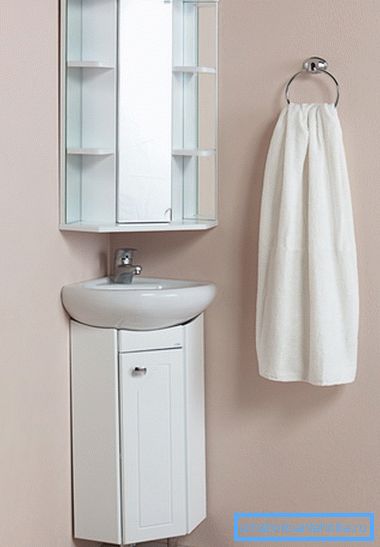Corner sink with cabinet - a universal option
Designers claim that the sink, by itself, without additional accessories will not look like a self-sufficient object, even if it is placed in the corner. From this point of view, a corner sink with a cabinet for a toilet, bathroom or kitchen is an almost ideal solution. Firstly, the room takes on a finished look, and secondly, it is convenient from the point of use.
On the varieties of such plumbing and the rules of its installation, we will discuss further.
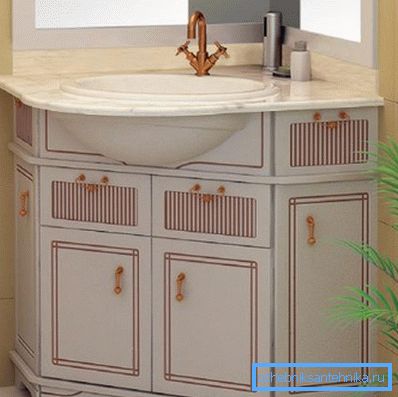
What are the options
Before buying such a kit, you need to decide in what interior you are going to enter this miracle. After all, the corner cabinet under the sink for the kitchen and a corner for the bathroom or toilet are several different things.
First of all, you need to consider that the bathroom and toilet are rooms with high humidity. A kitchen requires a more careful approach to the layout with the rest of the furniture.
Suspended option
Suspended furniture of this kind is more typical for stylish, extraordinary rooms. If your bathroom has a large square, then this solution will allow you to expand the space even more noticeably, creating the illusion of objects floating in the air (see also the article Ceramic sink: everything you need to know about it).
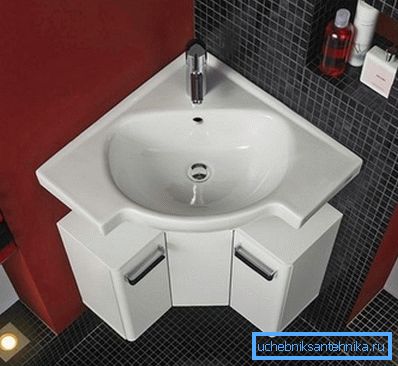
In small-sized bathrooms of standard city apartments, a suspended pedestal is more preferable from a practical point of view. The fact is that the bathroom and the sink in such nodes are very close.
Therefore, high humidity is felt especially strongly. The free space under such furniture allows air to circulate freely and to wipe the floor without difficulty.
Tip: sometimes in the houses of the old buildings on the floor are various boxes with communications, which seriously interfere with the installation, whatever the furniture. Hanging a cabinet over such a box, you completely remove this problem.
If we talk about the disadvantages of the suspended version, then to some extent, such is the impossibility of attachment to lightweight structures. Installation of this plumbing can only be carried out on solid bearing walls.
It will be practically impossible to hang such a corner on the plasterboard partitions. Plus, with the installation of the cabinets with their own hands will have pretty tricky.
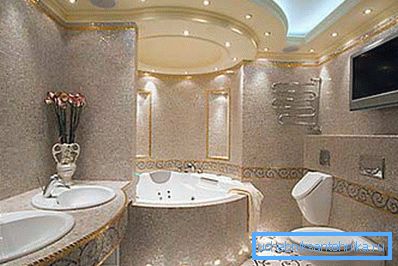
Leg stand
Corner sink for the bathroom with a drawer with legs is an intermediate option that can be installed in any room. No special installation skills are required at all. In fact, it is an independent furniture that is enough to put in a corner, like a regular closet of only smaller sizes.
As well as the mounted version, this design is perfectly ventilated and practically does not create obstacles for quick cleaning. Nightstands with legs are especially attractive in the case when a warm floor is laid.
Air circulation here does not interfere. Plus, if necessary, you can easily move away the corner and quietly repair communications.
As for the installation of the legs themselves, the instruction here is elementary simple. You need to choose a place to install and fix the legs with screws, using a screwdriver or a screwdriver. The assortment of legs on the market is huge, ranging from inexpensive plastic options to chrome-plated gold models, the price of which can be quite high.
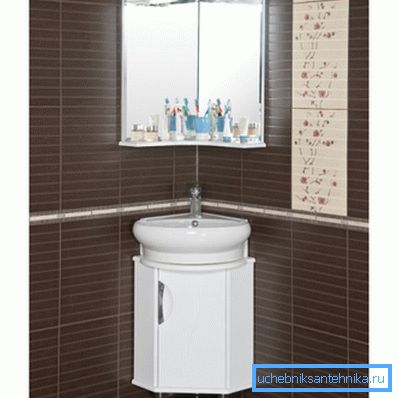
Tip: if you take the legs separately, it is better to give preference to individually adjustable models. Plus, experts advise to still fix the cabinet on the wall.
Constructions with base
Corner dresser with sink for bathroom with base, at the moment is the most common and popular option. The main reason for this is the complete look of the whole ensemble. The design looks completely poured into the wall, there is simply nothing to add or remove.
Often, this option is still preferred because of space saving. The sector under the pedestal is used at 100%, as a rule, this is the most convenient place for storing all kinds of cleaning and cleaning products, it is not rare that a plunger or cable is stored here, for quick cleaning of clogs.

Since the support is carried out around the entire perimeter of contact, such constructions are deservedly considered the most stable. Assembly and installation of such corners does not cause any difficulties.
But there is also a fly in the ointment in this elegant barrel of honey. If you want your furniture to serve for a long time and at the same time look decent, it is better to select the base from waterproof material. When installing the perimeter of the base, we advise you to lubricate with silicone, this will provide greater tightness, enhance the water-repellent function and protect from the fungus.
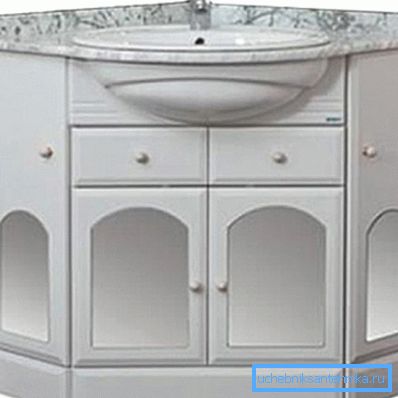
Tip: sometimes it makes sense to make a hybrid design. In other words, install a corner on the legs, and close the niche between the floor and the doors with overhead, removable panels. In working condition, the corner will look like a monolithic complex, but if necessary, the overhead panels can be easily dismantled for cleaning, ventilation or repair.

The material for the manufacture of cabinets
It is no secret that the bathroom and toilet are rooms with high humidity. Moreover, the smaller the room, the higher the humidity level.
As for the kitchen, then of course the conditions are more comfortable, but still the proximity and constant contact with water make themselves felt.
Therefore, materials for the manufacture of structures are used exclusively waterproof.

- The most common, at the moment material for toilets is MDF. Such a stove with sufficient resistance can withstand sudden changes in temperature and humidity in the room. This material is covered on top with a thin layer of plastic, which gives quite a tangible additional protection.
- The second number in this list is moisture resistant version of chipboard. If to be completely honest, the corner cabinet under the sink in the bathroom of chipboard, wins only at the expense of low prices. Models with legs and hanging structures can serve for quite a long time, but pedestals with a chipboard base, in spite of the protective coating made of plastic, quickly become useless.
- Products from a natural tree are considered as a separate elite niche. In view of the fact that for the manufacture of such corners, in most cases dense, usually deciduous varieties of wood are used, the price of this product is far from democratic. This is caused not only by the fact that the wood itself is expensive, but also by the need for a special wood pretreatment.
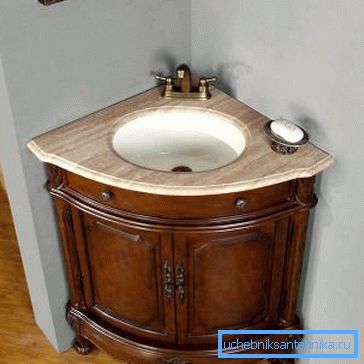
- The story will not be complete if we do not mention the recently emerged on the market products from plastic and thin metal. Among them are quite beautiful models with original design. But apparently the mentality of our people is not yet ready to massively adopt such innovations, so the demand for them is not great, although the quality of most products is high.
Tip: when choosing a corner, the main attention should be paid to the material from which the tabletop is made and, if there is, the base. The ideal option is considered a stone, while not so important artificial or natural, most importantly, that it does not deteriorate when exposed to moisture.
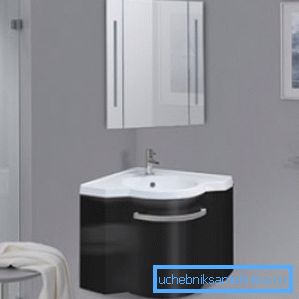
Washbasin dimensions
- In a limited space of city apartments, the installation of a small washbasin will be most appropriate. In this case, very tiny options are suitable except for the toilet. The use of such babies in the bathroom is impractical, since they can only rinse your hands, we are not talking about a full-fledged morning toilet.
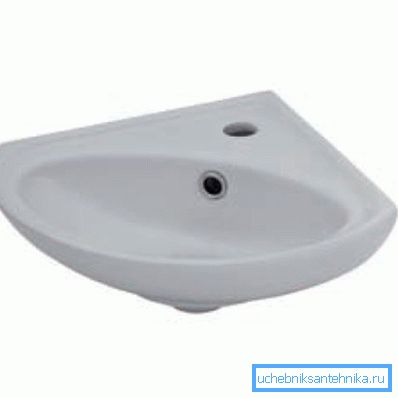
- Medium-sized corner cup fits perfectly in almost any bathroom. There is often enough space, as it is mounted close to the wall.
- As for the regular oval-shaped sinks, they are not often used in small rooms, since under them there is a rather wide tabletop protruding beyond the boundaries of the sink. Most of these models have an asymmetrical layout, this is when a playground is made to the right or left of the bowl.
- Washbasin with a wide bowl is installed in rooms where there is no need to save space severely, therefore such corners are made of sufficiently large sizes and are completed with wide mirrors and spacious drawers. This is a cross between a corner sink, based on a bollard and a dressing table for makeup.

A few words about the installation
There are few options here, the most common is a floor stand with legs or a basement, in which a bowl is rigidly mounted. Installation of this design does not cause difficulties even for inexperienced masters.
In fact, it is sufficiently tight to push it into a corner and it is desirable to fix it from the inside with a pair of anchors. In this case, the contact points of the tabletop with the wall should be smeared with silicone.
Everything is a bit more complicated if the cupboard and bowl are mounted separately. Here the main thing is to securely fix the bowl on the bearing wall. Anchors alone can be used to fasten extremely light structures of small dimensions.
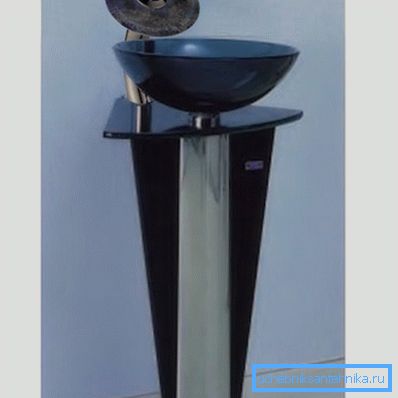
Wide bowls, having a large weight with anchors, are only pressed against the wall, and they must be supported on 2 brackets. Often each bracket is fixed with 3 anchors.
The curbstone, as in the first case, moves to the wall and is fixed on it. It happens that the cupboard has a size smaller than the diameter of the bowl and as it hides under it. In this case, the bollard, as a rule, plays the role of brackets.
The video in this article has additional material on this topic.
Conclusion
In conclusion, we would like to note that the corner sink with a pedestal, in a limited space of a bathroom or kitchen, is one of the central details of the interior. Therefore, giving preference to any model should be evaluated, primarily from the point of view of completeness of the composition (see also the article Suspended curbstone under the sink: features of choice, installation and operation).
